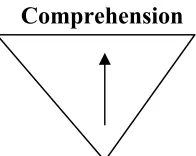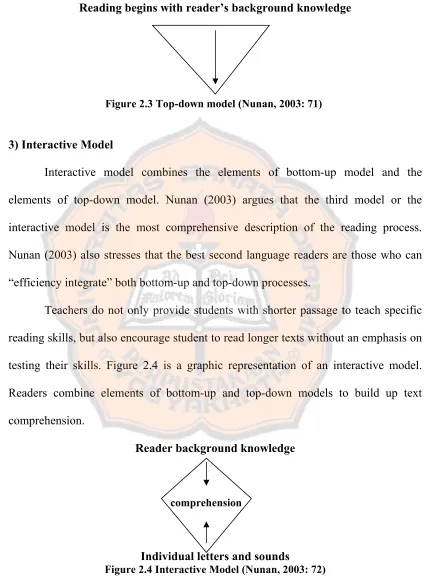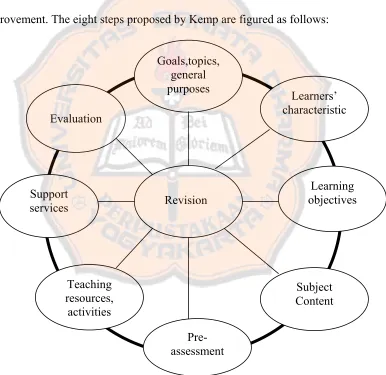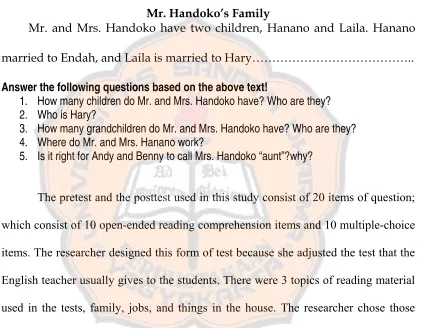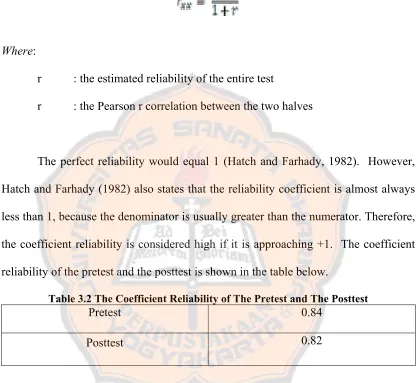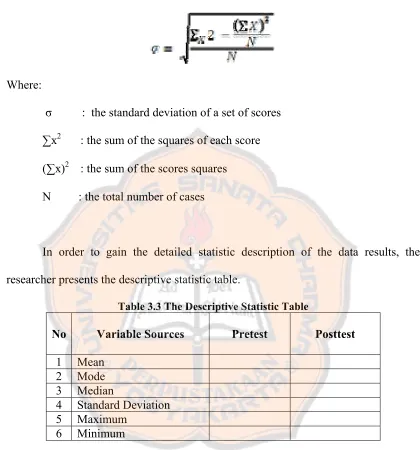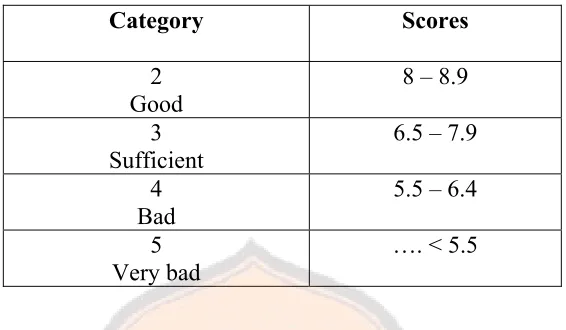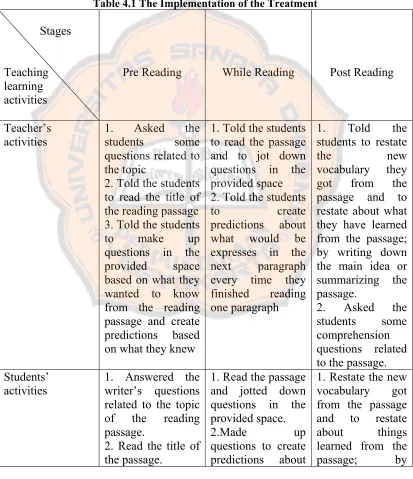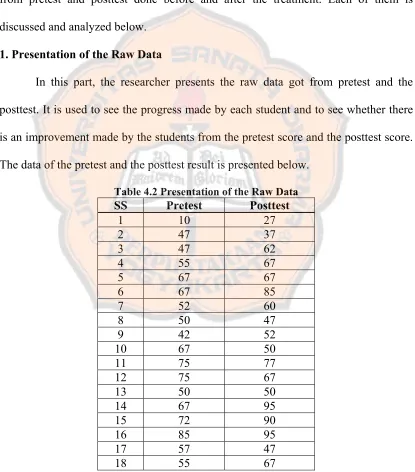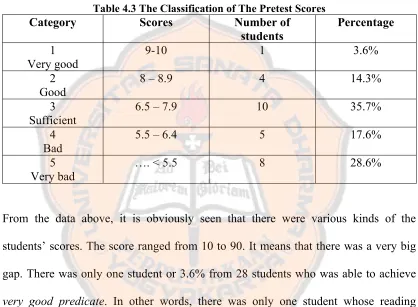i
A STUDY ON THE IMPLEMENTATION OF SELF-QUESTIONING TO IMPROVE STUDENTS’ READING COMPREHENSION
AT SMP MARIA IMMACULATA YOGYAKARTA
A THESIS
Presented as Partial Fulfillment of the Requirements to Obtain the Sarjana Pendidikan Degree
in English Language Education
By
Fransisca Agustin S. 051214074
ENGLISH LANGUAGE EDUCATION STUDY PROGRAM DEPARTMENT OF LANGUAGE AND ARTS EDUCATION FACULTY OF TEACHERS TRAINING AND EDUCATION
SANATA DHARMA UNIVERSITY YOGYAKARTA
iv
Be True to Your Heart
And Your Dreams Will Come True
Stay true to all your beliefs and goals.Stand tall.
Through all life’s setbacks and disappointments, your dreams will come true.
When no one else is with you, and no one seems to care,
just whisper to yourself, "I am the controller of my destiny. It’s up to me what comes to pass, and if I keep my thoughts positive and strong,
my dreams will come true."
When what seem to be impossible obstacles stand in your way, just think of all the times
you got through yesterday. There is a place for you in this world.
Stay on your chosen path. All the power is within you; be true to what is in your heart.
Be honest within yourself; if you are, then you cannot fail.
Your dreams will come true.
~ Debra Ruegg−Jenkins ~
vii ABSTRACT
Suryaningtyas, Fransisca Agustin. 2010. A Study on the Implementation of Self-Questioning to Improve Students’ Reading Comprehension at SMP Maria Immaculata Yogyakarta. Yogyakarta: English Language Education Study Program, Sanata Dharma University.
Nowadays, there is research done to propose strategies to improve reading comprehension. Many researchers propose that self-questioning or readers’ generating questions could cause a greater degree of comprehension. However, all of the research was done in the participants who learn English as a first language. Therefore, the researcher decided to conduct study to find out if self-questioning improves reading comprehension in the participants who learn English as a foreign language through experimental research. There are two research problems formulated in this study: (1) How is the implementation of self-questioning strategy in the English classroom of the seventh grade students at SMP Maria Immaculata Yogyakarta? (2) Does the implementation of self-questioning strategy in the English classroom improve the seventh grade students’ reading comprehension?
The experiment method employed in this study was One Group Pretest Posttest Design. The sample of this study was chosen through cluster sampling. The instruments used to gather the data were interview, observation during the treatment, and the two types of tests, namely the pretest and the posttest. The observation sheet used in the treatment was field notes in order to record specific events happened during the treatment.
The analysis of the data was divided into two main parts to answer the research problems. Dealing with the first research problem of this study, the researcher implemented self-questioning into three main steps, namely, pre-reading, while pre-reading, and post reading. The steps were suggested by Armbruster and Osborn (2002) who propose steps of teaching reading. The steps were conducted by applying self-questioning as a strategy.
viii
Based on the discussion of the two problem formulations, the researcher proposes some suggestions and consideration for English teacher and other researchers who are interested to investigate further about the same topic in the last chapter of this thesis. The researcher expects that the suggestions could be beneficial for the teaching learning process.
ix ABSTRAK
Suryaningtyas, Fransisca Agustin. 2010. A Study on the Implemention of Self-Questioning to Improve Students’ Reading Comprehension at SMP Maria Immaculata Yogyakarta. Yogyakarta: Program Studi Pendidikan Bahasa Inggris, Universitas Sanata Dharma.
Saat ini telah banyak penelitian dilakukan untuk mengusulkan cara maupun strategi yang mampu meningkatkan kemampuan memahami suatu bacaan Penelitian-penelitian tersebut mengusulkan bahwa self-questioning atau kegiatan pembaca menuliskan pertanyaan akan meningkatkan pemahaman dalam membaca. Walau begitu, penelitian-penelitin tersebut dilakukan pada siswa yang belajar Bahasa Inggris sebagai bahasa pertama atau bahasa pengantar sehari-hari. Oleh sebab itu, peneliti melalukan penelitan untuk menguji apakah strategi self-questioning mampu meningkatkan pemahaman dalam membaca pada siswa yang belajar bahasa Inggris sebagai bahasa asing melalui penelitian eksperimen. Ada dua permasalahan yang dirumuskan dalam studi ini, yaitu: (1) Bagaimana penerapan strategi self-questioning di kelas siswa kelas 7 di SMP Maria Immaculata dijalankan? (2) Apakah penerapan strategi self-questioning di kelas mampu meningkatkan kemampuan siswa dalam memahami suatu bacaan?
Metode eksperimen yang diterapkan dalam studi ini adalah dengan menggunakan pola pretest and posttest pada satu kelompok atau One Group Pretest Posttest Design. Subjek penelitian pada studi ini dipilih menggunakan
cluster sampling. Alat yang digunakan untuk memperoleh data adalah wawancara, pengamatan yang dilakukan selama penelitian, serta dua macam tes berupa pretest and posttest. Lembar pengamatan yang digunakan selama penerapan strategi self-questioning adalah berupa catatan lapangan untuk mencatat peristiwa-peristiwa yang terjadi selama penerapan.
Analisa data di bagi menjadi dua pokok bahasan untuk menjawab rumusan masalah di atas. Sehubungan dengan permasalahan pertama, peneliti menerapkan strategi self-questioning dengan membagi tiga tahap aktifitas yaitu pre-reading,
while reading, dan post reading. Langkah-langkah tersebut disarankan oleh Armbruster and Osborn (2002) yang mengungkapkan metode dalam mengajar membaca. Tiga tahapan aktifitas tersebut diterapkan dengan strategi self-questioning.
x
hypothesis ditolak. Arti kata lain, penerapan strategi self-questioning strategy tidak secara signifikan meningkatkan kemampuan siswa kelas 7 SMP Maria Immaculata Yogyakarta dalam memahami suatu bacaan.
xi
ACKNOWLEDGMENTS
Firstly, I would like to express my greatest gratitude to Lord Jesus Christ for His enormous blessing, guidance, and love given to me in accomplishing this thesis. He always stands by me whenever and wherever I need His help.
My gratitude and honor also go to my major sponsor Dr. Retno Muljani, M.Pd. who was willing to share her time reading and checking my thesis. Her knowledge, correction, suggestion, criticism, and support were very beneficial for me in finishing my thesis.
My thankfulness also goes to all PBI lecturers who have guided me during my study and PBI staffs (Mba Danik and Mba Tari) who have been very informative during my years of study in PBI.
Concerning to the data collection, I would also express my gratitude to the headmaster of SMP Maria Immaculata Yogyakarta who had let me do the research. I also thank Pak Adi, the English teacher, as he had given me opportunity and trust to conduct research in his class. My appreciation also goes to the seventh grade students of SMP Maria Immaculata, especially Class C, who became the participants of my research.
xii
their never-ending love, supports, advice, and prayer. They will always be the important people in my heart.
Life seems so hard if I have not got friends who have filled my life with joy and happiness and have supported me whenever I am down. I feel grateful to Datia, Rimas, Wahyu “Joex”, Tunjung, Nita, Adith “Kotak”, Endru, Daniel “Danconk”, Marshel’04, Yayas, Invani, Filus, and Kanya and those whose names cannot be mentioned one by one. I shall always remember every single moment we had and I shall always miss all those memories with them all!
I am also grateful to all members of Youth English Community (YEC) for all the wonderful experiences that I got through this organization. I shall always miss all “the adventures” that we had together. It is also my pleasure to thank All ELTI’s teachers and staffs for giving me an opportunity to join them and to develop my self more.
My special gratitude also goes to my boyfriend, Boni Aditya Firmanda, for all the sad and happy moments we have shared together. I thank him for his love, patience, and support especially in finishing my thesis.
Finally, I would like to thank all my friends and relatives that cannot be mentioned one by one. I thank them for all the support and prayers so that I can finish this thesis. May God bless them all!
xiii
TABLE OF CONTENTS
TITLE PAGE ... i
APPROVAL PAGES... ii
PAGE OF DEDICATION ... iv
STATEMENT OF WORK’S ORIGINALITY ... v
ABSTRACT... vii
LIST OF APPENDICES... xviii
CHAPTER I. INTRODUCTION... 1
CHAPTER II. REVIEW OF RELATED LITERATURE... 10
A. Theoretical Description... 10
xiv
2. Self-Questioning ... 21
3. Instructional Material Design ... 26
B. Theoretical Framework ... 28
C. Hypotheses ... 30
CHAPTER III. METHODOLOGY... 31
A. Research Method... 31
D. Data Gathering Techniques... 41
E. Data Analysis Techniques ... 42
F. Research Procedures ... 46
CHAPTER IV. RESEARCH FINDINGS AND DISCUSSIONS... 49
A. The Implementation of Self-Questioning Strategy ... 49
1. The Implementation Self-Questioning Strategy as the Treatment ... 49
2. Other Findings of the Implementation of Self-Questioning Strategy ... 55
a. Students’ Motivation... 55
b. Students’ Vocabulary Mastery... 57
B. The Pretest and the Posttest Result ... 58
1. Presentation of the Raw Data... 58
2. Data Presentation of Pretest ... 59
3. Data Presentation of Posttest ... 61
4. Data Presentation of the Pretest and the Posttest ... 64
5. Presentation of Descriptive Statistic ... 65
xv
CHAPTER V. CONCLUSIONS AND SUGGESTIONS... 74
A. Conclusions ... 74
B. Suggestions... 76
1. For Other English Teachers ... 76
2. For Other Researchers... 77
xvi
LIST OF TABLES
Table Page
3.1 Distribution of the Test Items ……… 38
3.2 The Coefficient Reliability of the Pretest and the Posttest ……… 40
3.3 The Descriptive Statistic Table ……….. 44
3.4 The Classification of the Scores ………. 44
3.5 The table of the raw data of the scores……… 45
4.1 The Implementation of the Treatment ……… 53
4.2 Presentation of the Raw Data ………. 58
4.3 The Classification of the Pretest Scores ………. 60
4.4 The Classification of the Posttest Scores ……….... 63
4.5 The comparison of Pretest and Posttest Scores ………... 64
4.6 Frequency Distribution of the Pretest ………..……… 66
4.7 Frequency Distribution of the Posttest ……… 66
4.8 The Table of Variability Computation of Pretest ……… ……… 68
4.9 The Table of Variability Computation of Posttest ………... 69
4.10 The Descriptive Statistic of Pretest and Posttest ………. 71
4.11 The Hypothesis Testing ……… 72
xvii
LIST OF FIGURES
Figure Page
2.1 The Definition of Reading ………. 12
2.2 Bottom-up Model ……….. 14
2.3 Top-down Model ………... 16
2.4 Interactive Model ………... 16
xviii
LIST OF APPENDICES
Page
APPENDIX A Letter of Permission ... 80
APPENDIX B Statement from SMP Immaculata Yogyakarta... 82
APPENDIX C The Materials ... 84
APPENDIX D The Pretest ... 102
APPENDIX E The Posttest... 106
APPENDIX F The Answer Keys... 113
APPENDIX G The Reliability of the Pretest ... 116
APPENDIX H The Reliability of the Posttest ... 119
APPENDIX I The Lesson Plans ... 122
APPENDIX J The Interview Result... 127
APPENDIX K The Field Notes ... 129
APPENDIX L The T-test Calculation ... 134
1 CHAPTER I
INTRODUCTION
In this chapter, the researcher would like to discuss the background of the
study, problem identification, problem limitation, problem formulation and also
definition of terms that were used in this study.
A. Background of the Study
Nowadays, mastering English as a foreign language has been considered as an
important skill in Indonesia. Moreover, in this globalization era, people are demanded
to be able to absorb and develop technology, science, culture, and art to build
relationships with other countries in this world (Depdikbud, 1994:1). That is the
reason why English is placed as a compulsory subject at schools and is taught as early
as possible. In other words, it is hoped that Indonesian students are able to obtain a
better acquisition of English.
In learning English, there are four skills that should be mastered. They are
listening, speaking, reading, and writing. Reading is one of the macro skills which
plays an important role. Carrell (1988) states that in the study of English as a foreign
language, the main motive why students learn language is reading. Muljani (2003)
also states that the ability to read in English is considered as an important skill in
countries where English is learned as a foreign language. This statement is supported
reading. The importance of mastering reading ability is also described in Nunan’s
statement:
Reading is an essential skill for learners of English as a second language. For most of these learners, it is the most important skill to master in order to ensure success not only in learning English, but also in learning in any content class where reading in English is required. With strengthened reading skill, learners will make greater progress and development in all other areas of learning (Nunan, 2003:69)
The quotation implies that mastering reading skill will influence the process in
mastering other skills. In line with Nunan, Carrell (1988) also states that second
language learners cannot perform at levels and cannot compete with native-speakers
counterparts without solid reading proficiency. In other words, mastering reading skill
in English should be regarded seriously because it is not a simple matter. Moreover,
reading does not involve one element only, yet it involves some elements. Dubin
(1988) states that reading is a complex skill which is made up of a number of
psychological and physical elements.
Reading activities do not focus on vocabulary acquisition, the structure of
reading texts, and the grammatical analysis. In teaching reading, the process of
teaching will not work effectively if teachers focus on those elements only. Students
need to be more exposed to the meaning of the texts and the message that the writers
want to convey from the texts. Therefore, comprehension is one important aspect to
achieve in reading activities. Muljani (2005) states that, foreign language reading has
Nowadays, there is research done to propose strategies to improve reading
comprehension. Singer (1985) as cited in Muljani (2005) conducted a study that
classified research-based hypotheses for testing strategies for improving reading
comprehension into three categories. The first was related to input stimuli, the second
was related to cognitive process for encoding, storing and retrieving information, and
the third was related to output products. Concerning the second category, which
focuses on instructional procedure, he mentioned some studies on questioning
strategies. The studies proposed that self-questioning or readers’ generating questions
could cause a greater degree of comprehension.
Self-questioning is the ongoing process of asking questions before, during,
and after reading that are used by a reader to understand texts (anonymous, 2005).
Wong (1985) and Rosenshine and Chapman (1990) as cited in King (1992) concluded
“when students receive adequate training in how to generate questions, their use of
self-questioning during or after reading usually results in improved comprehension”.
In line, Muljani (2005) also states that readers who are accustomed to
self-questioning are able to engage themselves in independent reading activity effectively
and efficiently. Using this strategy, readers or students are expected to be more
critical with the reading text that they are dealing with. In other words, readers or
students can be led to become an active reader in their attempts to achieve
comprehension through self-questioning strategy. Helfeldt and Henk (1990) as cited
in Muljani (2005) state “it is expected that through this self-questioning, the reader
Considering that comprehension is an essential goal in reading activities and
that self-questioning strategy may develop students’ reading comprehension actively,
therefore this research is intended to find out whether or not self-questioning strategy
really brings positive impacts on the students.
B. Problem Identification
Reading is regarded as one of important subjects in language learning. Carrell
(1988) states that “reading is by far the most important of the four skills in a second
language, particularly in English as a second or foreign language”. For some
students, reading is regarded as a complicated task since they have not mastered
English yet (i.e. lack of vocabulary). In consequence, it is hard for them to achieve
comprehension as the goal in reading. Regarding the situation, a good strategy is
needed in reading process. Thus, teachers attempt to provide students some
instructional help to lead students become independent and critical in their purpose to
achieve comprehension.
Questions are a common tool for teachers to guide students to comprehend
reading texts. Miciano (2002) states that teaching learning process invariably uses
questions and answer format because the questions focus on reader’s attention and
increase the potential of learning. However, Miciano (2002) also states “this format
place the initiative and option of defining the parameters of learning on the teacher,
relegating students to a passive, reactive role, fostering dependency and removing a
classroom, the teachers directly present the students with texts which they have to
read. After reading the texts, the teachers ask questions and the students answer.
Such a conventional classroom provides one-way interaction in which the students
will not be critical and not be involved with the reading text. Frase (1967) as cited in
Miciano explains (2002)“where teachers ask pre-posed questions and the students
read to answer them, comprehension tends to narrow because students are likely to
focus only on the passages related to the pre-posed questions”.
Considering the situation, the researcher found that self-questioning strategy
might become a good strategy to help students to gain comprehension in reading
process. Besides, there are many researches have proved that self-questioning is able
to improve reading comprehension. However, this strategy has not been implemented
widely by many teachers in Indonesia (Muljani, 2005). Therefore, in order to find out
whether this strategy really brings positive impacts on Indonesian students, an
investigation is apparently needed by applying self-questioning as the treatment for
the students.
C. Problem Formulation
Implementing self-questioning strategy for grade 7 of SMP Maria Immaculata
Yogyakarta leads the researcher to some questions which are formulated below:
1. How is the implementation of self-questioning strategy in the English
classroom of the seventh grade students at SMP Maria Immaculata
2. Does the implementation of self-questioning strategy in the English
classroom improve the seventh grade students’ reading comprehension?
D. Problem Limitation
This research is limited on two important factors. The first factor is that the
subjects of this study are the seventh grade students of SMP Maria Immaculata
Yogyakarta. Based on the interview with the English teacher before the study, it
turned out that this junior high school has realized the importance of increasing
students’ reading ability, since the students in the future will face UAN (Ujian Akhir
Nasional / National Examination) of which the most questions are about reading.Due
to the difficulties in getting permission and administrative requirement, this research
is only conducted in one class, which was randomly chosen, for the experiment.
Second, this research focuses on the implementation of self-questioning
strategy in reading lesson. It is taken into consideration because it might help both the
teacher and the students in reading lesson especially in English reading
comprehension. The English reading texts or the materials used in this research are
based on the syllabus of Junior High School.
E. Research Objectives
This research shares some objectives of self-questioning strategy in English
1. To discover how the implementation of self-questioning strategy in the
classroom.
2. To investigate whether the implementation of self-questioning strategy can
improve the seventh grade learners’ English reading comprehension or
not.
F. Research Benefits
The result of this study hopefully will give good contributions to people listed
below:
1. Other researchers
This research is expected to be helpful for other researchers who need it for
further studies on similar topic.
2. Teachers
This research is expected to give more insights to English teachers to develop
students’ ability to carry out effective reading in the context of EFL
classroom.
3. Students
This research is expected to make the students more critical and active in the
G. Definition of Terms
1. Self-questioning
Muljani (2003:106) argues that self-questioning refers to a reader’s activities
in generating questions directed to oneself before, during and after the process of
reading. King (1992) considers self-questioning to be a metacognitive strategy
because it provides learners with a way to test themselves in comprehending texts.
However, In this study, self-questioning refers to the ongoing process of asking
questions before and during reading used to understand texts. The questions generated
by the students could be correct or incorrect grammatically and could be in English or
in Indonesian since the focus is not the language used, yet the function of the
questions. In addition, in this study, the students were introduced and encouraged to
apply self-questioning as the strategy in reading activities.
2. Reading Comprehension
According to Smith and Robinson (1980), reading comprehension refers to the
understanding, evaluating, and utilizing of information and ideas gained through an
interaction between the reader and the author. In this study, reading comprehension
means the three kinds of comprehension suggested by Nuttall (1982), which are
literal comprehension, inferential comprehension, and critical comprehension. In
addition, in this study, reading comprehension refers to comprehension of English
3. Seventh Grade Students
Seventh grade students are those who are in the first year of junior high
school. In this research, they are the seventh grade students of SMP Maria
10 CHAPTER II
REVIEW OF RELATED LITERATURE
This chapter presents the detailed theories which underlie the study of the
implementation of self-questioning strategy to improve students’ reading
comprehension at SMP Maria Immaculata. This chapter is divided into three sections,
i.e. theoretical description, theoretical framework, and the hypotheses. The theoretical
description will deal with the theories of reading and self-questioning and the
theoretical framework will present the most relevant and closely related theories
employed in this study.
A. Theoretical Description
1. Reading
Reading is the skill that becomes the main object of this study. Therefore, it is
important to know what reading is and what aspects related to this skill are.
a. The Nature of Reading
Reading is one of four basic skills in language learning. According to Barnitz
(1985) reading is a complex communication process in which the mind of reader
interacts with a text in particular setting or context. During the reading process,
readers construct a meaningful representation of a text through an interaction in their
Grobe and Stoller (2002:9) propose that reading is “the ability to draw
meaning from the printed page and interpret this information appropriately”.
However, they also state that the definition itself is insufficient as a way to
understand the true nature of reading abilities, because first, the definition does not
convey that there are a number of ways to engage in reading; second, the definition
does not emphasize the many criteria that define the nature of fluent reading abilities;
third, the definition does not explain how reading is carried out as a cognitive
process; and fourth, the definition does not highlight how the ability to draw meaning
from a text and interpret the meaning.
Another view on reading comes from Nunan (2003:68). He states that reading
is “a fluent process of readers combining information from a text and their own
background knowledge to build meaning. According to him, “the reader’s
background knowledge integrates with the text to create the meaning”. It means that
the background knowledge of the reader does influence the reader’s interpretation of
the textual meaning. In other words, background knowledge takes an important role
in the process of reading and will influence the success of reading comprehension.
Nunan (2003:68) also adds that strategic and fluent readings also play an
important role in reading process. He defines strategic reading as the ability of
readers to use different kinds of reading strategies to achieve the purpose of reading,
which is comprehension, and defines fluent reading as the ability for readers to read
The text Fluency Strategies
The Reader
the fluency and the strategies combined together define the act of reading. Figure 2.1
is the representation of the definition of reading.
Reading
Figure 2.1 The Definition of Reading (Nunan, 2003 : 68)
b. The Purpose of Reading
There are several purposes of reading as proposed by Grabe and Stoller
(2002:13). They are as follows:
1) Reading to search for simple information and reading to skim
Reading to search for simple information is a common reading method. In
getting this purpose, a reader usually employs the scanning and skimming ability. The
scanning ability is the ability to read the text for a specific piece of information or a
specific word. On the other hand, skimming deals with guessing where important
information might be in the text, and in doing so, the readers use reading
2) Reading to learn from texts.
It typically occurs in academic and professional contexts in which a person
needs to learn a considerable amount of information from text. Reading to learn is
usually carried out at a reading rate slower than general reading comprehension (due
to rereading and reflection to help remember the information for the reader).
3) Reading to integrate information, write, and critique texts
This purpose requires critical evaluation of the information being read so that
the reader can decide what information to integrate and how to integrate it for the
reader’s goal. In this respect, both reading to write and reading to critique texts may
be the task variants of reading to integrate information. Both require abilities to
compose, select, and critique information from a text.
4) Reading for general comprehension
Reading for general comprehension requires very rapid and automatic
processing of words, strong skills in forming the general meaning representation of
main ideas, and efficient coordination of many processes under very limited time
constraints.
c. The Models of Reading
The models of reading can be divided into three categories: bottom-up model,
1) Bottom-up Model
The bottom up model usually consists of lower level reading processes. The
reader will start with the sound recognition and fundamental basics of letter. Then
continuously the reader will start to recognize the morpheme and followed by the
recognition of words. These recognitions will build up to the identification of
grammatical structures, sentences, longer text. In short, it can be concluded that the
readers of bottom up model process letters, letter clusters, words, phrases, sentences,
longer text, and finally meaning in order to achieve comprehension.
To be successful readers, students must be able to break a word down into its
smallest parts, the individual sounds. Nunan (2003) states that all reading materials
are carefully reviewed so that the students are not exposed to the difficult vocabulary
which contains of sounds that the students have not been introduced yet. The typical
classroom focus based on the bottom-up model is what we call intensive reading
which involves a short reading passage followed by textbook activities to build up
comprehension skill.
Figure 2.2 is the representation of this model (Nunan, 2003). Readers begin
with the smallest elements to build up text comprehension.
Comprehension
2) Top-down Model
Grabe and Stoller (2002) characterize the reader of top-down model as
someone who has a set of expectations about text information and samples enough
information from text to confirm or reject these expectations. The reader of this
model uses his or her background knowledge and makes prediction based on that.
Then, the reader searches the text to confirm or to reject the prediction which has
been made. A passage can be understood although all of individual words are not
understood.
To teach reading based on the top-down model of reading, Nunan (2003)
argued that there are four key features:
1. It is a literature based approach; readers are exposed to a wide range of vocabulary.
2. The whole language is student-centered; the reader may choose what he or she
wants to read.
3. Reading is integrated with writing; reading activity will be followed
simultaneously by writing activity.
4. The emphasis is on constructing meaning; the focus is on meaning and keeping
language whole, not to breaking down into smaller units.
Extensive reading which means reading many books or longer texts becomes the
suitable classroom focus of the top-down model of reading. Figure 2.3 is a graphic
representation of a top-down model. Readers begin with the largest elements to build
Reading begins with reader’s background knowledge
Figure 2.3 Top-down model (Nunan, 2003: 71)
3) Interactive Model
Interactive model combines the elements of bottom-up model and the
elements of top-down model. Nunan (2003) argues that the third model or the
interactive model is the most comprehensive description of the reading process.
Nunan (2003) also stresses that the best second language readers are those who can
“efficiency integrate” both bottom-up and top-down processes.
Teachers do not only provide students with shorter passage to teach specific
reading skills, but also encourage student to read longer texts without an emphasis on
testing their skills. Figure 2.4 is a graphic representation of an interactive model.
Readers combine elements of bottom-up and top-down models to build up text
comprehension.
Reader background knowledge
comprehension
Individual letters and sounds
d. Reading Comprehension
International Reading Association defines comprehension as “(1) an active,
constructive process; (2) a thinking process before, during, and after reading; (3) an
interaction of the reader, the text, and the context” (Muljani, 2005). According to
Smith and Robinson (1980), reading comprehension is the understanding, evaluating,
and utilizing information and ideas through an interaction between the reader and the
author.
Reading comprehension does not merely involve students’ vocabulary
mastery, but it also involves students’ active thinking process, especially in activating
their background or prior knowledge. Armbruster and Osborn (2002) state that
reading is a process in which readers actively search for and construct meaning or
comprehend by relating what they are reading to their background knowledge.
Therefore, problems with background knowledge cause comprehension difficulties.
According to Nuttal (1982) combined with the opinion Rouch and Birr
(1984), there are four types of comprehension, namely: literal comprehension,
interpretation, critical, and creative comprehension.
1). Literal Comprehension
Literal comprehension is the basic foundation in comprehending a text. Rouch
and Birr (1984) state that “literal meaning pertains to an understanding of those
things directly stated in the text read”. They also add that the basis to comprehending
Questions words usually used in getting literal comprehension are who, what,
when, and where (Rouch and Birr, 1984). Those kinds of questions are the most
frequently asked by teachers. However, they only develop a superficial understanding
on written material.
2). Interpretation or Inferential Comprehension
Inferential comprehension refers to the ability to gain insights into things not
directly stated yet implied. According to Rouch and Birr (1984), this ability is
referred to as “reading between the lines”. In line, Smith and Robinson (1980) also
state that interpretation, students “read between the lines” make the connection
among individual stated ideas, make inferences, draw conclusion, or experience
emotion reaction.
Having inferential comprehension means that students are able to answer
questions whose answers are not directly stated in the text. In addition, according to
Rouch and Birr (1984), students are able to predict outcomes of the texts, to draw
conclusion, and to discuss cause and effect relationship, another skill of interpretive
reading that goes beyond simply picking out stated facts.
3). Critical Reading
To be critical in reading means being able to judge the worth of and evaluate
what is being read. In other words, understanding what is being stated should be
gained first before having critical reading. According to Smith and Robinson (1980),
critical reading demands the readers to evaluate and pass personal judgment on the
higher-level processes of thinking. Thus, teachers must assist the students to become
involved with the thinking processes through recognizing misleading statements,
detecting bias, and separating facts from opinion (Rouch and Birr, 1984).
4). Creative Reading
Creative reading is not achieved unless the foundation of literal and inferential
comprehension has been laid. Creative reading includes the ability to visualize, solve
problems, generate new ideas, and elaborate on or change.
e. The Steps of Teaching Reading
According to and Ambruster and Osborn (2002:78), there are 3 steps for
teaching reading which are divided into:
1) Pre-reading activities
This activity is carried out as the introduction of the reading activity or as the
phase of before reading. This step is important because the learners should be
prepared to what they are going to read. In this stage, the learners will set their prior
knowledge, appropriate reading purpose, predict what the text will be about, select
reading method which appropriate with their reading purpose, and also expand the
learners’ background knowledge through the discussion activity. The techniques used
in this stage are:
a) to evoke the learners’ thoughts, the learners preview the content of the text by
b) activating the learners’ appropriate prior knowledge through questioning about
what they already know about the topic and the vocabulary of the reading passage,
c) setting the purposes for reading by asking questions about what they want to learn
during the reading activity process.
2) While-reading activities
The important thing emphasized in this stage is to understand the text. The
first thing that can be done is by doing the scanning or skimming task so that the
learners are helped to understand the text before doing the next task which will
demand for a more complex comprehension. To monitor the learners’ comprehension
is the key point of the activities that are carried out in this stage, which can be done
through a variety of strategies and experience. The techniques used in this stage are:
a) checking understanding of the text by paraphrasing the author’s words,
b) monitoring comprehension and use fix-up strategies,
c) integrating new concepts with existing knowledge; continually revising purposes
for reading.
3) Post-reading activities
The activities in this stage should provoke the learners to review their
understanding of the text, relate new ideas to their background knowledge, revisit the
text to clarify and extend meaning, apply the information to other texts and discipline,
3. Self-Questioning
One activity to “train” a reader to become aware is through
self-questioning (Cheung, 1995). According to Helfeldt and Henk (1990) and Gillespie
(1990) as cited in Muljani (2005:106), self-questioning is a term used to refer to sub
cognitive strategy employed by a reader in his quest for following reasons:
1) to make sense of written texts by asking him or herself what questions about the
texts that he or she might encounter.
2) to satisfy his or her purposes in reading in addition to answering questions
generated by his or her teacher or the author.
Self-questioning may be considered a natural of comprehension process where
the reader tries to generate questions directed to him or herself in his or her attempts
to conduct effective reading. Therefore, in some studies, self questioning is employed
as a reading strategy which can be taught and trained to readers and of course to
students (Muljani, 2003 : 106 ).
Costa (2000) as cited in Muljani (2003), states that generating questions may
not be an easy task since this activity has to proceed through stages, e.g. problem
identification, question articulation or formulation, and social editing. He also
suggested that the act of generating question can be affected by some variables. They
are:
1) Cognitive variables
According to Wong (1985) as cited in Muljani (2003), the example of
reader does not have background knowledge of what he or she just read. In
consequence, it will be hard for the reader to generate questions, since the reader is
not equipped with any single information about the text they read.
2). Personal variables
This variable deals with achievement, attention, motivation, and self-esteem,
which can influence the question generation. Readers who have high motivation tend
to generate more questions than readers who are not so motivated (Costa, 2000 in
Muljani (2003).
3). Contextual variables
Contextual variable deals with the source of reading materials, subject matter,
difficulty level, text type, and task type, which can also influence the questions
generation. Costa et al. described that
“ students are likely to ask more questions when they are exposed to certain subject matter such as science; books or articles published by authorized publisher are likely to encourage their readers to generate questions concerning their contents. In exam-driven task, students are likely to generate more questions than when they are given daily or weekly assignments.” (Costa, 2000 as cited in Muljani, 2003:109)
Barns, Roe, and Ross (1984:203) state that students should perceive some
type of questions in generating questions of different comprehension skills. The types
of questions are:
1) main idea question,
2) detail question,
type of question which asks for small pieces of information conveyed by the text or
the material
3) vocabulary question,
type of question which asks for the meaning of words used in the material or the text
4) sequence question,
type of question which requires knowledge of even in the order of sequence
5) inference question,
type of question which asks for detailed information that is implied but not directly
stated in the text
6) evaluation question,
type of question that requires students to make judgments about the material that they
have read
7) creative response question,
type of question which asks the student to create new ideas on the ideas that they
have made.
Meanwhile, according to Muljani (2005), there are two types of effective
self-questions. They are cognitive and metacognitive types. The cognitive questions may
help a reader comprehend the text (Helfedt and Henk, 1990, in Muljani, 2005), and
the metacognitive type may help a reader monitor a reader’s thinking to read
effectively and efficiently (Muljani, 2005). Nuttal (1982) divided the cognitive
1) literal questions,
type of questions which concerns on the information explicitly stated the a text,
2) inferential questions,
type of questions which concern on the information implicitly stated in a text,
3) evaluative question,
type of questions which can be answered by providing judgment, evaluation, solution,
based on what the text writer says and what the reader thinks,
4) reorganization questions,
type of questions which can be answered by reorganizing information from different
part of a text,
5) personal questions,
type of questions which cannot be put into any categories. The answers to these
questions depend mostly on the reader instead of the writer.
Dealing with direct instruction to teach students self-questioning strategy,
Pearson and Gallagher (1983) in Armbruster and Osborn (2002 : 77) state that there
are many instructional studies designed to teach students to generate questions which
have resulted in improving comprehension. The direct instruction that most of these
studies used are teaching the students the key question-starting words (who, what,
where, why, when, how), teaching generic questions or questions stems, teaching
students to compose questions based on the main ideas, and teaching students to use
story grammar categories to generate questions. Meanwhile, an article entitled
http://www.specialconnections.ku.edu/cgi-bin/cgiwrap/specconn/index.php, mentions
7 steps in applying self-questioning strategy.
Step 1: Tell yourself, "I need to question the author and predict where the author is going."
Step 2: Read the passage and identify clues that make you question the author. To identify question clues, look for words, phrases, sentences, or pictures that make you curious.
Step 3: Ask yourself good questions. Ask yourself, "I wonder..."questions."
The "I wonder" questions use "wh' and "h" words. These words are include: who, what, when, where, why, which, how, how many, and how much.
When you ask yourself a question, think of a way to remember the question, so you don't forget it as you read. For example, in the margin in light pencil (or a separate piece of paper), draw a picture of a face to help you remember a "who" question.
Step 4: Create predictions. For each question you ask, create a prediction based on what you are thinking and what you know.
Step 5: Keep questions and predictions in mind as you read.
As you read, keep checking to see if your questions are answered and your predictions are confirmed.
Step 6: Evaluate the answers.
If your questions are answered, remember the answer. If not, keep them in mind as you continue to read. If your prediction is correct, remember the answer. If your prediction is not correct, restate what the correct answer is and adjust your thinking.
Step 7: Review what you know and read on.
Restate what you know from your questions. Focus on what you learned from the information that the author actually gave you. Summarize the main ideas and details that are critical to understanding the author's message.
In applying self-questioning, teachers need to guide students especially in
giving instruction and providing practice that help students learn to continuously
question, predict, confirm, correct, and reconcile information when they read.
Meanwhile, if teachers only ask students to self question and read without describing
and routinely modeling how to use an appropriate self-questioning strategy, the
4. Instructional Material Design
There were many instructional material designs proposed by some experts.
However, in this study, the researcher used instructional material design model
proposed by Kemp (1977) to develop reading material based on self-questioning
strategy as the material used in the treatment. The designed reading material applied
Kemp’s model because of its flexibility and simplicity.
There are eight steps in Kemp’s instructional material design (1977). The
steps are described as follows:
Step 1: Considering the goal and then list the topics, stating the general purposes in
teaching each topic. It is done to know or to figure out what the students are expected
to learn.
Step 2: Stating the learners’ characteristic. By knowing the students’ characteristic, it
will be easier to conduct the teaching learning process, especially in managing the
class and in choosing the material for the students.
Step 3: Specifying the learning objectives. It deals with what is/are hoped from the
students to be able to do after the teaching learning process.
Step 4: Listing the subject content, which has the close relationship with the
objectives and the students’ need.
Step 5: Developing pre-assessment to determine the students’ background and present
Step 6: Selecting teaching learning activities and instructional resources that will treat
the subject content so that the students will be able to accomplish the objectives.
Step 7: Coordinating support services, such as budget, personnel, facilities,
equipment, and schedule to carry out instructional plan.
Step 8: Evaluating students’ learning in terms of their accomplishment of objectives,
with a view of revising and re-evaluating any phase of the plan that need
improvement. The eight steps proposed by Kemp are figured as follows:
B. Theoretical Framework
As stated in Chapter 1, there were two objectives to be achieved in this study.
The first objective was to discover how the implementation of self-questioning
strategy in the classroom and the second objective was to investigate whether the
implementation of self-questioning strategy can improve the seventh grade learners’
reading comprehension of English texts or not. In order to address the research
problems, this study implemented three major theories, namely self-questioning
strategy, the steps of teaching reading, and reading comprehension theory
Firstly, the researcher implemented self-questioning theory and the steps of
teaching reading in order to address the first research problem. Ambruster and Osborn
(2002) state that there are three steps of teaching reading, namely pre-reading
activities, while reading activities, and post-reading activities. In this study, the
researcher applied these steps by using self-questioning strategy. Muljani (2005)
states that self-questioning refers to a reader’s activities in generating questions
directed to oneself before, during and after the process of reading. The act of
generating questions itself was done in the steps of teaching reading, especially in
pre-reading and while reading activities. For example, as the introduction of the
reading activity, the students generated the question by looking at the title of the
reading text in order to evoke the students’ thought and to activate the students’
appropriate prior knowledge
Secondly, the researcher implemented reading comprehension theory
research problem. Comprehension is an essential thing to be achieved in reading
process. Comprehending a text does not merely mean knowing the information
directly stated in the text, which means in the level of literal comprehension. Rouch
and Birr (1984) state that if a reader only recognizes who, what, when, and where
questions (literal-meaning questions), he or she will only develop a superficial
understanding of written material. Muljani (2005) also states that “when a reader is
successful in making sense of the text he is likely to reach literal, inferential, and
critical or evaluative comprehension”. Therefore in this study, to improving students’
reading comprehension means to guide students to reach literal, inferential or
interpretive comprehension, and critical or evaluative comprehension.
As what many researchers state that the theory of self-questioning is related
to reading comprehension, this research would implement the three major theories
discussed above to find out whether or not the implementation self-questioning
strategy improves students’ reading comprehension of English texts through
experimental research. Having discovered how the implementation of
self-questioning strategy, the researcher would find out whether the null hypothesis of this
C. Hypotheses
The hypotheses are:
1. The Conceptual hypotheses
Ho: Implementing self-questioning strategy is not effective to improve reading
comprehension of seventh grade learners at SMP Maria Immaculata Yogyakarta.
H1: Implementing self-questioning strategy is effective to improve reading
comprehension of seventh grade learners at SMP Maria Immaculata Yogyakarta.
2. The operational hypotheses
Ho: There is no significant difference between the means for the pretest and the
posttest
H1: The mean for the posttest is higher than the mean for the pretest.
3. Statistical hypotheses
Ho: μpretest = μposttest OR
μ pretest - μ posttest = 0
H1: μ pretest ≠μ posttest OR
μ pretest - μ posttest ≠ 0
31
CHAPTER III
METHODOLOGY
In this chapter, the researcher will discuss the methodology which was used to
answer the two questions stated in Chapter 1. This chapter presents (1) the research
method, (2) the research setting and participant, (3) the research instruments, (4) the
data gathering technique, and (5) the data analysis technique.
A. Research Method
In this study, the researcher employed experimental research as the research
method. According to Fraenkel and Wallen (1993: 241), experimental research is the
only type of research that attempts to influence a particular variable. They also claim
that experimental research is the best way to establish the cause and effect
relationships between variables. Thus, the researcher used an experimental research
in order to notice what is going to happen to the subject of the study after
implementing the self-questioning strategy as the treatment. In addition, the
researcher also conducted library research to get information related to
self-questioning as a strategy in reading activity which becomes the main aspect in this
study.
Fox (1969:459) states that the key element in planning the experimental
research is the identification of independent variable and the dependent variable. In
strategy in the reading lesson, and the dependent variable was the reading
comprehension of the seventh grade learners. The researcher investigated whether the
implementation of self-questioning strategy in the classroom, especially in the
reading lesson, brings some effects on the seventh grade learners’ reading
comprehension.
The experiment method employed in this study was One-Group
Pretest-Posttest Design (Ary Donald., Lucy Cheser Jacob, and Asghar Razavieh, 2002). This
method was used to investigate the improvement of reading comprehension after the
treatment. The difference of pretest and the posttest results in the single group of
sample became the main data for the researcher to conclude whether self-questioning
improved students’ reading comprehension or not. Ary et al, (2002) concludes that
there are three steps involved in one-group pretest-posttest design. They are as
follows:
1. administering a pretest measuring the dependent variable,
2. applying the experimental treatment X to the subjects,
3. administering a posttest, again measuring the dependent variable.
As mentioned in step 1, in this study the researcher administered the pretest to
measure students’ reading comprehension prior to the treatment. Before conducting
the test, the researcher consulted the form of the test to the English teacher. Next, the
researcher conducted self-questioning strategy in the reading lesson as the treatment
as mentioned in step 2. Having conducted the treatment, the researcher administered
one-group pretest-posttest design. The students’ scores obtained from the pretest and
the posttest were then compared to see whether there was a significant change or not.
According to Ary et al (2002), the major limitation of One-Group
Pretest-Posttest Design is that because no control group is used. Thus, this design lacks of
internal validity. Therefore, to eliminate the situation, he also suggests ways to
control potentially contaminating situational variables which are holding the variables
constant and manipulating the variables systematically from the main independent
variable. Holding the variables constant means having the same conditions under
which this study occur, for example having the same teacher, the same day, the same
time, and the same room. In other words, in this study, the teacher who gave the
treatment was only the researcher herself. It was conducted every Thursday at 09.45
a.m. up to 10.30 a.m. in the same class. Meanwhile, manipulating the variables
systematically means by controlling the order in which experimental conditions are
presented.
B. Research Setting and Participants
This study was conducted in SMP Maria Immaculata Yogyakarta located at Jl.
Brigjen Katamso no.4 Yogyakarta. As mentioned before, the subjects in this study
were the seventh grade students. Since there were 6 classes, it was not feasible to
conduct the experimental research to all classes. Therefore, the researcher used the
cluster sampling to select the samples. “Cluster sampling is a kind of probability
naturally together” (Ary et al. 1990:175). According to Fraenkel and Wallen (1993),
the cluster sampling can be used when it is difficult to select a random sample of
individuals. They also add that this kind of sample is often far easier to implement in
school and frequently less time-consuming. Thus, through cluster sampling, the
writer chose class A as the sample in this study.
There were 30 students in class A. The students were between 12-13 years
old. All of them had already learnt English since in the first grade of elementary
school. The characteristic of the students were various; some of them were very
active in the teaching learning process but there were also students who were passive
or even ignorant.
C. Research Instruments
The research instruments aimed to collect data to answer the problems stated
in the Chapter 1, namely: 1) How is the implementation of self-questioning strategy
in the English classroom, and 2) Does the implementation of self-questioning strategy
improve the seventh grade learners’ reading comprehension? Therefore, the
researcher will mention some instruments used to gather those data.
1. Interview Guidelines
Interviews were used to get the data of subjects’ opinion, belief, feelings,
about a situation in their own words. The researcher interviewed the English teacher
to discover the general description of the teaching learning activities and the students’
the interviewee in answering questions and because the researcher wanted to know
the depth of the interviewee’s point of view. The interview dealt with the
interviewee’s needs, problems and comments about teaching reading in the
classroom. Therefore, the data obtained from this instrument were used to collect the
additional information about the students and the teaching learning process,
especially in teaching reading before conducting the treatment.
The type of the interview was general interview guide approach. The
researcher chose this type of interview because it provides more focused questions
than the informal approach, in which no predetermined questions were asked, but it
still allows a degree of freedom and adaptability in getting information from the
interviewee.
2. Observation Sheet
The second instrument used to collect the data was observation sheet.
Observation sheet helped the observer to study phenomena such as patterns of
learning when they occur in real life situation (Nachmias, 1997). Therefore,
observation sheet was used in order to record data during teaching learning activities.
The observation sheet used was field notes. Field notes contain what the
observer saw and heard. Field notes have two components. They are the descriptive
part, which includes a complete descriptive of a setting, people, or sequence of
events, and the reflective part or observer comment, which includes the observer’s
the students, but also on the process of how the implementation of self-questioning
strategy, and on what the teacher or the instructor did.
3. Tests
The third instruments used in this study were tests. The tests were used to
measure the students’ reading comprehension before and after the treatment. The tests
administered in this study were categorized as achievement tests, since in this study
the researcher measured students’ improvement in comprehending texts. As what
Hughes (1989:10) states, achievement tests are directly related to language courses,
their purpose being to establish how successful individual students, group of students,
or the courses themselves have been achieving objectives. In this study, the objective
was to improve the students’ reading comprehension. The tests were needed very
much in obtaining the score in order to know the effect of self-questioning strategy as
the treatment to teach reading skill. The scores were obtained through pre-test and
posttest.
The pre-test was conducted at the beginning of the experiment. It was used to
discover the students’ reading comprehension before the treatment. The content of the
pre-test was the materials that the students had at beginning of the semester. The
posttest was conducted at the end of the experiment or after the treatment. It was used
to discover whether the implementation of self-questioning strategy as the treatment
of the study would bring some beneficial effects to the students’ reading
According to Ary et al. (2002), a research always depends on the
measurement. The measurement of the instrument included the test validity and
reliability. “A test is said to be valid if measures accurately what it is intended to
measure” (Hughes, 1989 : 22). According to Hughes (1989), there are several types of
validity. In this study, the writer applied content validity, construct validity, and face
validity.
a. Content validity
Hughes (2003) in Brown (1991), states that a test is said to have content validity
if the test samples the subject matter about which conclusions are to be drawn, and if
it requires the test taker to perform the behavior that is being measured. This study
focused on students’ reading comprehension. Therefore, in this study, the test items
that the researcher composed required the students to comprehend the texts given
only because the aim of the test was to measure the students’ reading comprehension.
b. Construct validity
As stated by Hughes (1989 : 26), a test is said to have construct validity if it can
measure just the ability which it is supposed to measure. Since in this study the
researcher wanted to measure students reading comprehension, then the test items that
the researcher composed did not merely test the students’ literal comprehension, but
also the students’ inferential and evaluative comprehension.
c. Face validity
“A test is said to have face validity if it looks as if it measures what it is
researcher consulted the tests to the English teacher. It was done in order to know
whether the students were familiar with the tests or not. The sample of the test used in
this study is as follows:
Reading 1
Mr. Handoko’s Family
Mr. and Mrs. Handoko have two children, Hanano and Laila. Hanano
married to Endah, and Laila is married to Hary………..
Answer the following questions based on the above text!
1. How many children do Mr. and Mrs. Handoko have? Who are they? 2. Who is Hary?
3. How many grandchildren do Mr. and Mrs. Handoko have? Who are they? 4. Where do Mr. and Mrs. Hanano work?
5. Is it right for Andy and Benny to call Mrs. Handoko “aunt”?why?
The pretest and the posttest used in this study consist of 20 items of question;
which consist of 10 open-ended reading comprehension items and 10 multiple-choice
items. The researcher designed this form of test because she adjusted the test that the
English teacher usually gives to the students. There were 3 topics of reading material
used in the tests, family, jobs, and things in the house. The researcher chose those
topics because the students had learned the topics before. The distribution of the test
items is listed below.
Table 3.1. Distribution of the Test Items
No Topics Numbers of items in the test
1 Family 5 (open-ended items), no.1-5
No Topics Numbers of items in the test
3 Things in the house 5 (open-ended items),no. 16-20
d. Reliability
According to Best (1986 : 154), a test is said reliable if it measures accurately
and consistently, from one time to another. Since the researcher employed split half
technique which was calculated using the Pearson Product Moment, then the
estimation was continued by using Spearman-Brown prophecy formula. The formula
of Pearson Product Moment (Pearson r correlation) and Spearman-Brown prophecy
are described as follows:
1. The Pearson Product Moment (Pearson r correlation)
r
=
Where:
r : Pearson r
∑N : the sum of scores in X distribution
∑J : the sum of scores in Y distribution
∑N2
: the sum of the squared score in X distribution
∑J2
2. The Spearman-Brown prophecy
Where:
r : the estimated reliability of the entire test
r : the Pearson r correlation between the two halves
The perfect reliability would equal 1 (Hatch and Farhady, 1982). However,
Hatch and Farhady (1982) also states that the reliability coefficient is almost always
less than 1, because the denominator is usually greater than the numerator. Therefore,
the coefficient reliability is considered high if it is approaching +1. The coefficient
reliability of the pretest and the posttest is shown in the table below.
Table 3.2 The Coefficient Reliability of The Pretest and The Posttest
Pretest 0.84
Posttest 0.82
The table shows that the coefficient reliability of pretest was 0.84 and the
coefficient of the posttest was 0.82, which means that the coefficient reliability of
each test was highly significant because it is approaching +1 (Best, 1970). In other
words, both the pretest and the posttest were able to measure accurately and
consistently, from one time to another. The computation of the coefficient reliability
D. Data Gathering Technique
The data were gathered through the interview guidelines, the observation
sheet, and the tests as the instruments of this study. The first instrument used to get
the data was the interview guidelines. The interview guideline was used in conducting
the interview which was done before the experiment. To be able to conduct the
interview, the researcher lobbied the English teacher to arrange the interview time.
There were five questions that should be answered by the English teacher. The
questions were about the students’ description, the class activities that were usually
done in the English lesson, especially in reading lesson, the classroom atmosphere,
and the obstacle in teaching reading. The questions were intended to discover the
teaching learning process that the students usually have.
The second step was administering the pre-test. The pre-test was done to get
the information about students’ reading comprehension before the treatment. In the
pre-test, the students had to read some reading passages and then had to answer the
comprehension questions given. The score obtained from the pre-test would be
compared to the score obtained from the posttest, which was done after the treatment.
After administering the pre-test, the researcher started to conduct the
experiment, which was lasted for 4 meetings. The researcher was the one who
implemented the treatment. Before giving self-questioning strategy to the students,
the researcher and the English teacher had a little discussion about the materials used
in the treatment. Since the researcher acted as the teacher, it was difficult for her to
